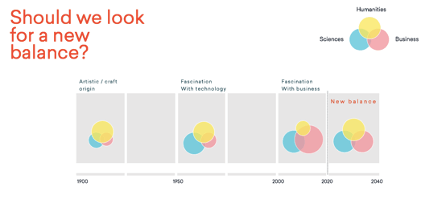“The power of design to create a better future”
Juliane Trummer, Blake McEldowney y Millaray Vega

For years we have been pushing our environment to the limit, and now the Earth is pushing back. It is at moments like this that humanity needs to reorient itself. The discipline of design must do the same.Â
Those of us who work in design are aware of its evolution throughout the past century and can proudly affirm that the influence and power of design has increased exponentially. At the start of the 20th century design focused on the aesthetic and the visual. Then, in the 1950s, our fascination turned towards technology. Design entered the new millennium as a consolidated discipline that added value to the business world. This has given design more visibility. What can we do with it?
At turning points, such the one we are experiencing today, we must rethink our “why”, our purpose. Looking back through history once again, we can see how design has always been at the service of economic growth: from the Industrial Revolution, to design for mass production, to post-war reconstruction.
For decades now we have focused on the user within a consumer society, which has led us to where we are today: designing experiences in a world that is globalised and experiencing an existential crisis. We have come to realise that economic growth is not enough to accomplish well-being, so we must ask ourselves: what is next?
Design as a discipline has always had a culture of critical thinking and ethical responsibility that is activated at key turning points. We need a new balance and a more systemic view.
We need to move away from the traditional user-centred formula and ask ourselves: why are we doing this and for whom? It might be the right opportunity to move from user-centric design to understanding users as just one element of a whole that encompasses our ecosystem, our planet. Whenever we refer to feasibility, let’s think beyond technology. When we think of viability, we must consider knock-on effects and externalities.
Finally, we should be cognizant of the power of design. Having a systemic vision will allow us to anticipate the future, facilitate change and, above all, help businesses find ways to be more sustainable. All this is within our power.
If you would like to learn about how Mormedi can help your company innovate contact us at madridHQ[at]mormedi.com.


